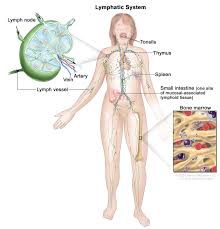When breast cancer spreads to the lymph nodes, it may need more intensive therapy than cancer that stays localized, and it can be overwhelming. You can better understand your diagnosis, course of treatment, and prognosis if you are aware of lymph node involvement.
This guide describes what happens when breast cancer spreads to the lymph nodes, how staging is affected, potential symptoms, and available treatments.
What Are Lymph Nodes?
Your lymphatic system, which supports your immune system, includes tiny, bean-shaped structures called lymph nodes. They have immune cells that assist your body fight infections by removing dangerous substances from the lymph fluid.
When tumor cells separate from the main tumor and go to neighboring lymph nodes via lymph vessels, breast cancer may spread. Although there are clusters of lymph nodes close to the breastbone (sternum), the axilla, or under the armpit, is often where the lymph nodes closest to the breast are found.
The sentinel lymph nodes are the first nodes to receive drainage from the breast tissue and are often the first place cancer spreads. Even if cancer reaches these nodes, it does not automatically mean it has traveled to other organs, though lymphatic or bloodstream involvement increases the risk of metastasis.
According to American Cancer Society, the 5-year survival rate for breast cancer confined to the breast is over 99%, while it drops to 87% when nearby lymph nodes are affected.
Breast Cancer Staging and Lymph Nodes
After a breast cancer diagnosis, doctors need to determine whether it has spread beyond the primary tumor. This is essential for developing an effective treatment plan.
Methods for staging breast cancer include:
- Clinical Prognostic Stage: Uses health history, physical exams, imaging, and initial biopsies. Lymph nodes may be evaluated via mammograms, ultrasounds, or MRI.
- Pathological Prognostic Stage: After surgery, tissue and lymph nodes are analyzed to provide a more precise stage.
- Anatomic Stage: Focuses on tumor size and spread using the TNM system; rarely used in the U.S.
In the TNM system, lymph node involvement is represented by N:
- NX: Nodes cannot be measured
- N0: No cancer in nearby lymph nodes
- N1: 1–3 axillary nodes or a few nodes near the breastbone involved
- N2: 4–9 axillary nodes affected or enlarged mammary nodes
- N3: 10+ axillary nodes involved, or nodes under the collarbone affected
Other factors influencing staging include tumor grade (cell abnormality) and biomarker status (ER, PR, HER2).
For more details on staging, visit National Cancer Institute.
Symptoms of Lymph Node Involvement
Early spread to lymph nodes may not cause noticeable symptoms. As cancer grows, common signs can include:
- Lumps or swelling in the armpits or around the collarbone
- Enlarged lymph nodes even without a breast lump
Enlarged lymph nodes can also occur due to infections or non-cancerous conditions. If you notice unusual swelling, it’s important to consult your doctor.
Treatment Options for Breast Cancer with Lymph Node Spread
Treatment depends on multiple factors: tumor size, grade, stage, hormone and HER2 receptor status, and genetic factors. Common treatments include:
1. Surgery
- Lumpectomy: Removes the tumor and some surrounding tissue, preserving most of the breast.
- Mastectomy: Entire breast is removed.
- Sentinel lymph node removal is performed during both procedures.
2. Lymph Node Dissection
- Removes level 1 and 2 axillary lymph nodes.
- Can lead to lymphedema, a long-term swelling issue, especially if many nodes are removed.
- Possible side effects: numbness, reduced shoulder or arm movement.
3. Radiation Therapy
- Targets residual cancer cells, particularly in lymph nodes.
- Types include external beam radiation and internal radiation (brachytherapy).
4. Chemotherapy
- Kills cancer cells throughout the body.
- Often used for aggressive cancers or when there’s a risk of spread beyond lymph nodes.
5. Hormone (Endocrine) Therapy
- Blocks estrogen receptors or reduces estrogen levels in ER-positive cancers.
- Medications include tamoxifen, aromatase inhibitors, and LHRH agonists.
6. Targeted Therapy
- Focuses on specific cancer markers such as HER2.
- Options include monoclonal antibodies, tyrosine kinase inhibitors, ADCs, CDK inhibitors, mTOR inhibitors, PARP inhibitors.
7. Immunotherapy
- Helps the immune system attack cancer cells.
- Typically reserved for triple-negative breast cancer.
8. Clinical Trials
- Trials can provide access to novel therapies. Ask your oncologist if you’re eligible.
More information about treatments can be found at Mayo Clinic – Breast Cancer.
Understanding Your Diagnosis
No two breast cancer experiences are the same. Understanding your type, stage, and treatment options empowers you to make informed decisions alongside your oncology team. Key discussion points with your doctor include:
- Stage and grade of cancer
- Hormone and HER2 receptor status
- Surgical options and reconstruction
- Treatment goals, side effects, and monitoring
Takeaway
Breast cancer is considered to be at least stage 2 when it spreads to the lymph nodes. Involvement of lymph nodes is crucial in establishing prognosis and therapy plans.
You can take an active role in your care and collaborate with your medical team to select the best treatments if you are aware of the characteristics of your cancer.
